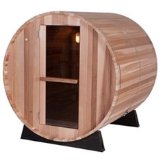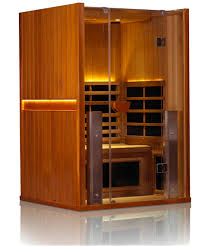How is a Traditional Sauna Different Than the Infrared Type?
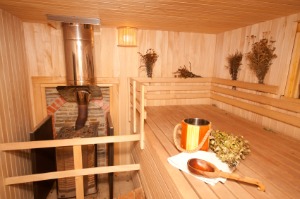 |
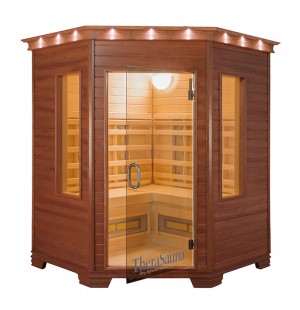 |
The sauna is one of the oldest health and wellness traditions known to man, having originated in Finland over 2,000 years ago. The original saunas were nothing more than crude pits dug into a hillside or berm where they could actually be used as a residence during the cold winter months.
The sauna was fitted with a fireplace containing stones that were heated to a high temperature. Steam could be created by pouring water over the stones.
From this humble beginning, the sauna began to grow in popularity, taking hold throughout the Nordic nations and eventually spreading throughout Europe and to North America.
As the Finnish word “sauna” translates most closely to “bath” in English, it’s not surprising to realize that the purpose of the sauna was to cleanse the body, inside and out, by promote intense sweating. As the pores are open and the body sweats, it flushes out built up toxins, helping to improve overall health.
At the same time, the heat of the sauna can help to ease painful joints and when alternated with cold baths, can actually help to boost immune system function, and improve the health of the skin.
Though the original Finnish saunas used wood burning stoves as a heat source, some found them complicated and a nuisance to maintain so, as with many inventions, the sauna was “improved” over time with the introduction of more modern heating alternatives.
Today, there are a variety of options including traditional saunas that use gas or electric heaters and the most recent addition to the sauna lexicon, infrared technology.
So how can the average consumer choose which type is right for them? It helps to understand the specifics of each option so that you know exactly what you’re getting.
With that in mind, let’s take a closer look at the modern world of saunas:
The Traditional Wood-Burning Sauna
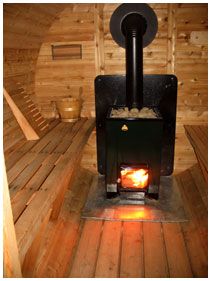
As stated above, the earliest traditional saunas were found in Finland and dated to before the Middle Ages. The use of a sauna sprung from the need for a place to relax and cleanse the mind. From ancient times, man understood the need to cleanse the body of impurities and the most immediate way to do so was through the body’s natural response to heat, sweating.
For the most part these earliest saunas were separate buildings, apart from a family’s main residence. They were large enough to be used by many people at once and were often treated as a social gathering spot. Because using a sauna could have such a positive effect on the mind as well as the body, it almost took on a spiritual element and to this day is treated with something close to reverence by the Finnish people.
The earliest saunas used a wood burning fireplace topped by a layer of stones. This method is still quite popular in Finland today. In this type of sauna, the stones become super heated by the fire and the heat emanates into the room.
The heat and humidity level can be regulated by pouring water over the stones, which produces steam. Some people prefer more steam than others, but the purification effect is the same either way. Traditional wood burning saunas can also be used outdoors, where users often increase the health benefit by dipping into a natural cool water source either before or after their sauna session.
Let's take a look at the main pros and cons to the traditional wood-burning sauna experience...
Pros: These are generally larger rooms that can comfortably contain several people, which provides a social aspect to the sauna experience. They are ideal in areas where there is no electricity as they don’t depend on the electrical grid and for sauna purists the wood smoke adds another beneficial element to the overall experience.
They also include the option of a hot water tank, another benefit for “off the grid” living and are generally the cheapest and most cost effective method.
Cons: Since they rely on wood fires, which can take some time to reach maximum heat, it may take as long as 30-40 minutes for the sauna to fully heat up. Also, wood burning saunas are the least convenient of all as they require continual cleaning to avoid a build-up of ashes and a continual supply of wood. Plus the wood smoke can be unpleasant for some users.
Alternative #1: The Gas Heated Sauna
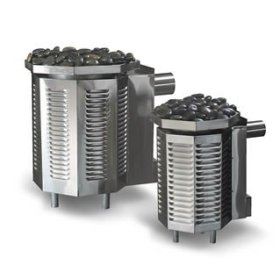
As the benefits of the sauna began to be recognized outside of the Nordic region, they began to gain in popularity and to evolve to meet the needs of a more modern and urban society. After World War II, when German soldiers fighting on the Russian/Finnish front were first introduced to the Finnish sauna tradition, they brought the experience back home with them and it began to take hold.
Since this type of sauna experience was communal, it soon took hold in public places such as gyms and baths. In these facilities, the heating method of choice became gas.
So rather than burning wood to heat the stones, they just connected a gas line. Let's look at the pros and cons of the gas sauna heater...
Pros: When used regularly, as in a gym, they have a quick heat up time and a low operation cost, making them ideal for commercial use. Also, gas burns cleanly so it is easy to maintain an even temperature and there is no smoke or ash to clean up.
Cons: Gas heaters are large, heavy and require professional installation. Even though they have a low operation cost, it can take many hours of continual use to offset the extremely steep installation cost, making them a less attractive option for most personal or residential users.
Alternative #2: The Electric Heated Sauna
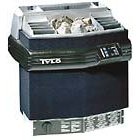
As the market for personal home saunas began to increase, the focus on heating moved from gas to electric. Not only did this make installation easier, it also enabled the construction of smaller saunas that could easily be incorporated into a private home.
The electric heating units provide the same benefits of their predecessors with a lot less effort to install and a much quicker heat up time. This makes it easy for users to fit their regular sauna time into their busy schedule.
Let's look at the pros and the cons...
Pros: Electric heaters work much quicker than traditional wood burning saunas, reaching maximum heat in as little as 20-30 minutes. Many even feature programmable controls that allow you to pre-set the heater so that your sauna is already fully heated before you get to it. With today’s Bluetooth technology, you can even program your sauna from your smart phone so that it’s ready by the time you walk into your house.
Cons: Since electricity is required, these saunas can’t be used in remote locations or outdoors. Some sauna purists also dismiss the electric option as it lacks the added experience of wood smoke as well as lacking the communal feeling of larger, traditional saunas.
Alternative #3: The Infrared Sauna
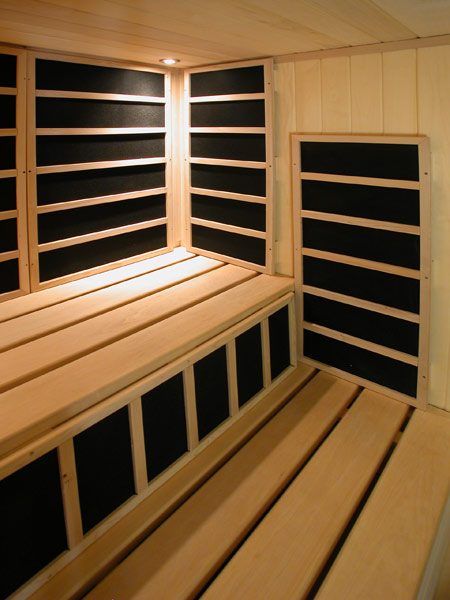
The latest addition to the world of saunas, Infrared technology allows for a whole new sauna experience. Unlike traditional saunas, which use steam to encourage sweating, in infrared saunas heat waves permeate the body and increase the core temperature, which then results in sweating.
This is similar to the experience you have when sitting in the sun on a warm day. As the rays of the sun warm your body, your temperature increases and you begin to sweat even though you are sitting in a dry environment. The overall effect of the infrared sauna on the body is much the same however, with the sweat flushing out toxins and the heat working to soothe muscles and open the pores to cleanse the skin.
There are pros and cons to the infrared sauna as well...
Pros: While traditional saunas must reach maximum heat level to provide any benefit, with an infrared sauna you can begin to bathe the moment the room is turned on as the infrared energy is instantly emitted by the heaters. If you prefer to wait for maximum heat, that generally takes no longer than 15 minutes. Infrared saunas are also smaller, easier to install and very user friendly. Some infrared saunas even incorporate colored light therapy, sound systems and full-glass fronts for a more private escape.
Cons: Sauna purists generally believe that the sense of community they provide is an important part of the overall therapeutic experience and therefore avoid infrared saunas as they are geared to a much more individual experience. You also don't get the "hot room" experience of the other methods, and the heat from the panels penetrates the skin directly, rather than warming the air.
Traditional vs. Infrared - What's Your Best Option?
Naturally, you can use any form of sauna in your home and there many makes and models of each currently available on the market. The type you choose will depend heavily on exactly what you want to get out of your sauna experience.
If you’re looking for the refreshing, communal and spiritual experience that incorporates the outdoors and is still a mainstay in Finland today, then you’ll want to choose a wood burning sauna.
If your idea of using a sauna is popping into the steam room at the gym after your daily workout, then a gas or electric unit may be for you.
However, if you want the benefits but not the high temperatures, an infrared sauna might make sense for you.
If you’re in the market for a home unit, you’ll want to pay particular consideration to the practical aspects of the two most popular choices for this use, electric and infrared.
Most electric heated saunas are designed for use by multiple people, though you can get smaller one or two person units. These generally use a 4.5 kW heater, 240 volt, 1 phase power which draws 18.8 amps and requires a dedicated line and breaker.
This size heater costs an average of $.37 to run for the first hour and $.25 for each subsequent hour.
Compare that to an infrared sauna, most of which are much smaller than traditional saunas and use about 1.5-1.7 kW using a 120 volt 15 amp plug-in service. Since infrared saunas heat up faster, they are generally used for less time and so the cost averages out to $.18 an hour for a two-person sauna.
The purchase and installation cost of traditional saunas can range from $3,000 for the smaller models to upwards of $11,000 for larger models. Electric units are fairly easy to install while gas heaters will usually require professional installation to ensure safety.
In comparison, infrared saunas provide a more economical option for the home user, costing anywhere between $1,100 and $5,000. They are easy to install and take up much less room, making them easy to incorporate into any home.
Finally, both forms of sauna offer multiple health benefits, including removing heavy metals and other toxins from the body; reducing stress by melting away tension and promoting better sleep; improving skin tone by clearing cellulite and hydrating cells and pores; burning calories and promoting weight loss; relieving the pain of arthritis, muscle spasms, joint stiffness and sprains; and strengthening the cardiovascular system by increasing heart rate, cardiac output and metabolism and stabilizing blood pressure.
When it comes down to it, the Finns knew what they were doing when they first explored the idea of a sauna experience. It’s a natural, refreshing way to promote good health and alleviate stress while balancing mind and body. With today’s advances in technology it is easier than ever to get all the benefits of a sauna in the comfort of your own home without spending a fortune.
Consider everything that saunas have to offer and you’ll be able to find the option that works best for you. Then your whole family can begin to enjoy the healing goodness of a sauna experience!
Infrared Saunas
Sauna Heaters
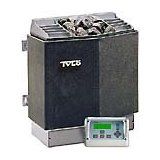
How to Install a Wood Sauna Heater
Sauna Kits
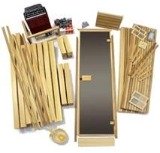
Buying Guide
